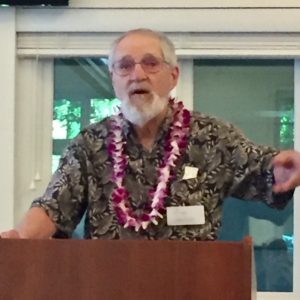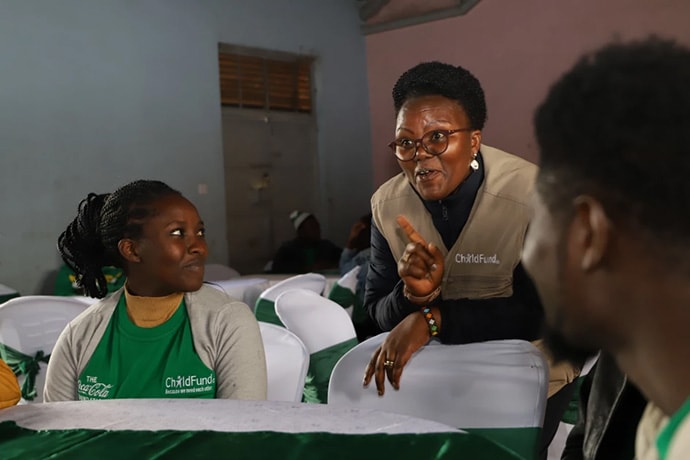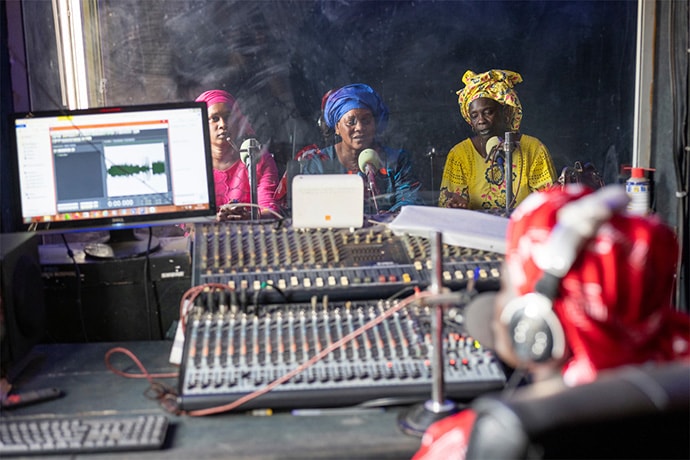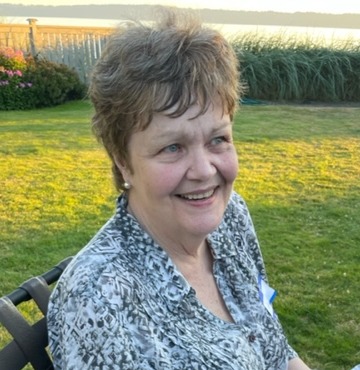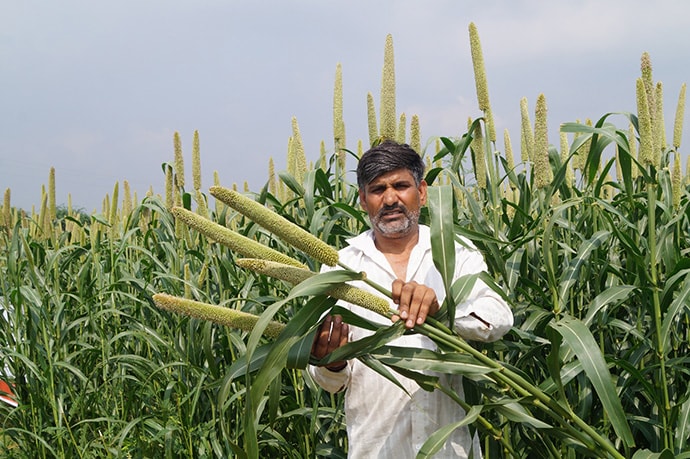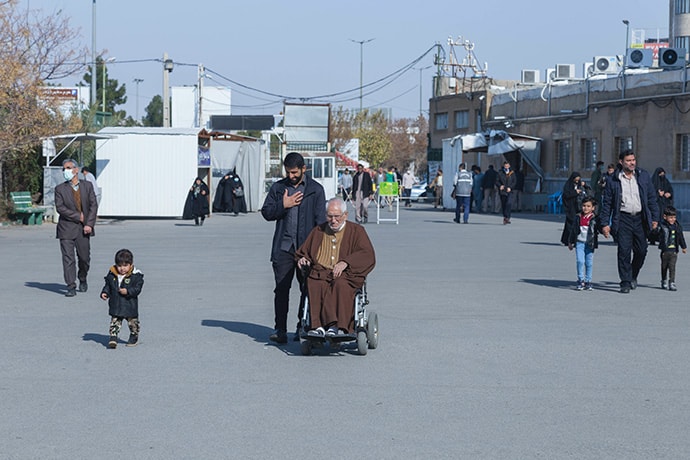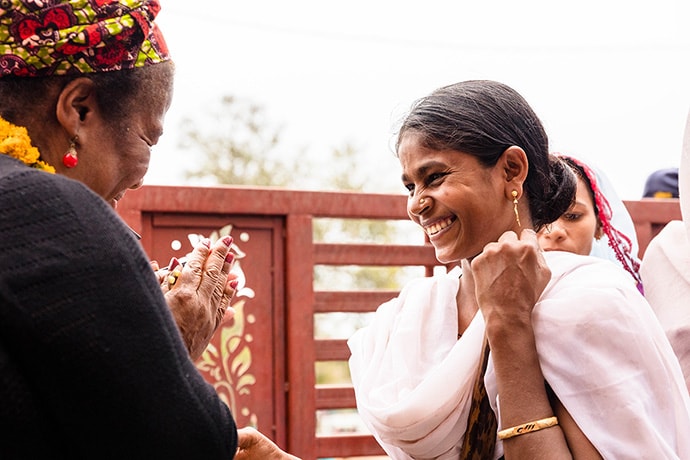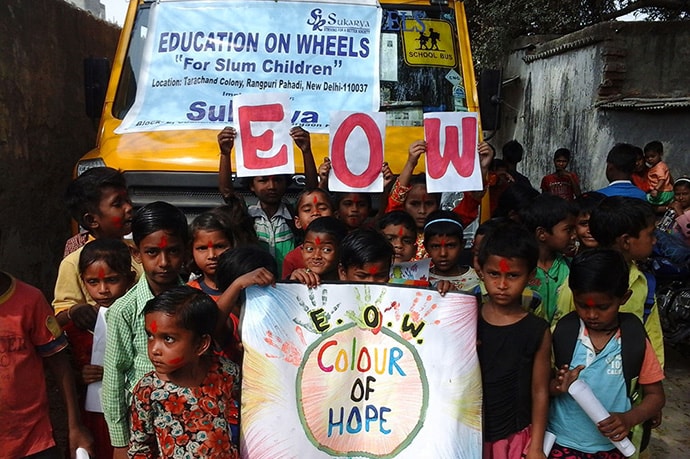Welcome to the May/June 2023 issue of the Global Washington newsletter.
IN THIS ISSUE
Letter from our Executive Director

The Pacific Northwest is known for innovation, technology, engineering, and an awareness to mitigate the damaging effects of climate change. That ethos is evident in our Global Washington members who are creating climate solutions that increase food security and reach the Sustainable Development Goal 2 of Zero Hunger.
This includes sustainable and resilient agriculture that are both high-tech and low-tech informed by proven indigenous knowledge. Read more about Global Washington members working on these issues below. To learn more about technology solutions to agriculture and land management, join us at a virtual event on June 21st featuring DE Design.
Global Washington is also hosting and co-hosting a number of up-coming events:
Hope to see you soon at one of our events!

Kristen Dailey
Executive Director
Back to Top
Issue Brief
Rebuilding Agriculture for Growing Hunger | Sector Innovations in the Wake of Climate Change
By Aneesh Chatterjee
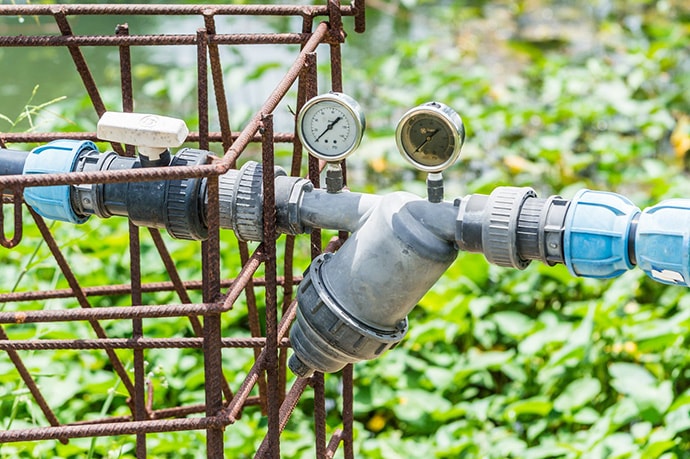
Water irrigation valves on an African farm. Photo: Toodlingstudio/Pixabay
The global hunger crisis is irrefutably linked with rampant climate change, where increasingly turbulent and destructive weather events contribute to growing challenges in the agriculture sector. Rising global temperatures and sea levels lead to droughts, unpredictable rain patterns, floods, and other extreme weather events, leading to widespread displacement of populations and damaging the durability of global food production systems. NGOs worldwide work every day to develop and implement versatile solutions to the growing impacts of climate change on the agriculture industry, and on food access as a whole.
The following GWA members are active in developing a robust response to climate change affecting agriculture, investing in innovative solutions to build an adaptable and sustainable future for food production.
Leading technological advances
Broad-spectrum digital innovation is vital to the deployment of solutions for climate change. Microsoft’s AI for Earth initiative is leading digital innovation in climate change, with 950 projects deploying 20 solutions across the world, working with 50 established partners. Their premiere cumulative work, the Planetary Computer, has built an elite and comprehensive database for climate data across every sector of study, an invaluable tool for any enterprise seeking to pioneer new solutions for the climate crisis and its impact on world hunger.

At a more focused scale of operation, DE Design + Environment Inc. has designed multiple projects to simulate and understand the complexities of climate change risks. Their agricultural risk maps for the Inter-American Institute for Cooperation on Agriculture, built simulations and conducting risk analysis for environmental disasters in the focus regions of Guyana and Trinidad and Tobago. DE has also built the TroFCAA (Tropical Forests and Climate Change Adaptation) project, analysing climate change risks posed in Africa, Indonesia, and Central America. The TroFCAA initiative was commissioned by the Centre for International Forestry Research to understand the best ways to develop climate policy, specifically to implement in Costa Rica, Nicaragua, Honduras, Mali, Ghana, Burkina Faso, and Indonesia.

Heifer International, in partnership with Texas A&M, Engineers Without Borders, and the Milwaukee School of Engineering, spearheaded several innovative strategies to bolster the efficacy of cardamom farms in Guatemala. Deemed a fairly profitable but vulnerable crop, cardamom farmers are at odds with pests that can reduce crop value by up to 70%, and inefficient drying methods for their harvests.

The initiative developed solar-powered industrial drying units that call for smaller cardamom batches while drying, improving both crop yield and reducing environmental impact – in addition to introducing organic fertilizers and pesticides. Heifer has also taught simple preservation techniques in Honduras, such as using candles to remove the oxygen from bean storage silos, extending their longevity. Heifer Kenya has utilized technology to a great extent by implementing digital monitoring solutions for dairy farmers. Partnering with Farming Tech Solutions Ltd., Heifer provided farmers with access and training for the DigiCow Dairy app, through which they can share knowledge in chat rooms, schedule veterinary checkups for cattle, and engage with other virtual training opportunities.
The importance of reuse
Recycling waste material is an essential pillar of sustainability, as some members demonstrate through their projects. Heifer promotes the importance of recycling as a crucial step toward agricultural resilience. Working with farmers across the world, Heifer teaches pit composting and vermicomposting to revitalize and enrich soil, and the utilization of dung and water in biodigesters to create biogas, a methane-based clean energy source usable in cooking. In the Indian state of Bihar, for instance, the distribution of biodigesters via Heifer’s partnership with Sistema.bio has improved agricultural efficiency, reduced emissions from conventional fuel usage as well as from discarded animal waste, and drastically lowered household expenditure on conventional fuel.

The Starbucks Foundation also sees the importance of recycling. With an announcement of a $10 million investment in Circular Services, the largest private recycling enterprise in the US, the goals of this investment are to reduce the shipping of recyclable material to landfills and redirect them toward use in consumer products, packaging, electronics, and other sectors. Partnering with Nestle, PepsiCo, Microsoft, SK Group, Brookfield, Unilever, and the Partnership Fund for New York City, the Starbucks Foundation is contributing to a total investment of nearly a billion dollars in Circular Services to reduce landfill waste and redistribute recyclable materials, a significant step toward a more sustainable future.
Instruction and accessibility
Teaching vital skills and providing access to resources for farmers is essential groundwork for building a sustainable future for agriculture. Strengthening capacity for climate change resilience has been a priority for The Hunger Project (THP). Their approach includes sustainable farming, promoting access to modern agriculture technology, raising awareness of climate change and the necessity to adapt, and driving reforestation efforts to build back ecosystem resilience.

Across Africa, THP has built community farms that teach composting, techniques for increasing crop yield, rebuilding soil fertility, and other essential agricultural skills for local farmers. By providing training and credit, communities are empowered to invest in sustainable and resilient farming practices, building stable agricultural systems in the face of climate change. The Project’s Climate Committees invite all members of these communities to participate in workshops, activities, build skills, raise awareness, and foster leadership. In India, similar workshops are held to promote awareness of the climate change crisis and build leadership capabilities in local communities, inspiring them to take autonomous steps toward resilience.
In Malawi and Ghana, THP is building greater access to agricultural solutions in partnership with USAID, Microsoft, and Bluetown, through the Meaningful Access Initiative, emphasizing greater access for women seeking information, training on sustainable farming, and product markets. Ecostoves, an innovative solution to reduce reliance on wood for burning and improve air quality, have been installed in Mexico by THP in partnership with Water for Humans, and greatly alleviates the impact of deforestation and air pollution.
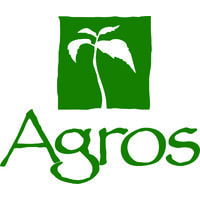
Another member building hands-on skills is Agros International. Engaging with local communities in Nicaragua and Guatemala, Agros is teaching sustainable agriculture through innovative irrigation practices, providing families with small farms where the philosophy of producing more with less is paramount. Modern technologies that can increase crop yields, maximize profits, and contribute to the problem of food scarcity, are being invested in and introduced to farmers. To address the versatile and complex problems of each region, Agros has developed Harvest of Hope Centers (HHCs) that provide specialized and tailored solutions to unique regional challenges, allowing ease of access to resources for locals.
Heifer International maintains the value in preserving the health of livestock, deploying versatile solutions to improve the quality of life and wellbeing of farm animals across the world. By providing farmers with information and training using extension services, Heifer has contributed to building better animal shelters, providing medical assistance, and connecting farmers with technology solutions to bolster efficiency and resilience. In the realm of livestock preservation, Heifer has led vaccination and deworming campaigns for farm animals in order to combat zoonotic diseases, preventing animal-to-human infections and preserving the wellbeing of livestock. In a 2017 initiative, vaccinations reduced the mortality rates of chickens in Zambia from 60% to 5%. Heifer health workers have also demonstrated widespread impact on cows in Malawi, preventing infections and preserving the health of up to 3150 cows across 380 households per worker – a number magnified by the 3461 total health workers trained by Heifer across the world as of 2019. Heifer Bangladesh built efficient and cost-effective hatching pots for chickens in 2014, increasing the yield of poultry farms, and built effective housing for poultry in Senegal, protecting them from direct heat – a major contributor to chicken mortality rates.
Multi-sector engagement
Several GWA members are approaching the same complex problem with unique angles, such as Landsea. Landesa’s mission to secure autonomy and land rights for farmers in rural communities contributes to developing a resilient agricultural model in the face of climate change. Landesa states that if land rights are granted to local farming communities with full autonomy, it opens the way for them to invest in sustainable farming techniques, improve their irrigation practices and implement developing technologies in agroforestry and terracing at a faster pace – thereby strengthening adaptability in agriculture from the ground up.

Landsea’s Climate Program brief highlights the connection between securing land rights and combating the effects of climate change on agriculture and food scarcity. The implementation of direct land ownership is designed to incentivize investments in soil restoration, planting more trees to combat deforestation, build healthier ecosystems and prevent further erosion of agricultural prospects. These investments can also go on to adapt existing farming infrastructure, incorporating novel methods and technologies to combat the dynamic impacts of climate change.

Other organizations, like Argos International and the Earthworm Foundation, also recognize the importance of localized land ownership as a cornerstone of agricultural resilience, as participatory governance and local development capacity are both essential in building the groundwork for resilience. The Earthworm Foundation, consulting on the compositions of supply chains, places the farmers and producers at the core of their development model, building strong ground presence, promoting land autonomy, and using data to measure the impact of these developments. Their model predicts that a stable agricultural economy where farmers are their practices are prioritized will in turn stabilize a fragile ecosystem, generating a systemic approach to withstanding climate change.
Another specific angle of approach is deployed by the Starbucks Foundation, with their charitable initiatives targeting some of the most prominent resource scarcity issues – such as lack of access to clean water. Partnering with other members of the UN Water Resilience Coalition, the Foundation has pledged $25 million to WaterEquity’s Global Access Fund IV, part of their 2030 goal to reduce their water waste footprint by 50%. A total investment of $50 million will be invested in reaching water access, sanitation and hygiene (WASH) goals by 2030, with low-income populations in South Asia, South America and Sub-Saharan Africa targeted as the primary beneficiaries of these initiatives.
The Foundation’s water conservation efforts have also brought investment in the Qiandao Lake water replenishment project, an initiative to test methods for improving water quality in China’s basins, reduce soil erosion and runoff, and build pollution resistance by revitalizing wetlands to act as natural carbon sinks. Qiandao Lake’s water supply reaches nearly 10 million people in the Zhejiang Province, emphasizing the importance of this investment. In Mexico, the Starbucks Foundation has partnered with Alsea Foundation, World Vision and Planet Water Foundation to build 25 water towers and provide local populations with clean water access – the beneficiaries of which number around 45,000.
In addition to their advocacy for land rights, Landesa participates in widespread systemic change through their corporate engagement initiatives. Advising company policy on matters of land ownership and supply chains, Landesa has helped corporate giants like PepsiCo, Unilever, and Coca-Cola – an example of which is the ACRE Framework, used by PepsiCo to monitor land rights in their supply chains. GROW Africa is an example of grievance and complaint mechanisms developed by Landesa that may be used to submit and address land rights disputes. Landesa has worked closely with Illovo Sugar, Wilmar, and PepsiCo to train their staff in handling present and future land disputes and develop policies, addressing supply chain grievances, and build tracking systems to measure progress on meeting land rights commitments.
Beyond water access, the Starbucks Foundation aims to bring sustainable and resilient agricultural practices to coffee production. As per their 2022 Global Environmental and Social Impact Report, precision agriculture methods – such as the use of environmentally-friendly fertilizer that maximises coffee yields, using eco-wet mills to separate beans from coffee cherries such that water usage may be conserved (a system that projects up to a 90% increase in water conservation compared to traditional methods), and planting up to 100 million trees over 10 years that are engineered to be resistant to climate change-linked diseases like rust – demonstrate immense promise in the Foundation’s 2025 and 2030 benchmarks.
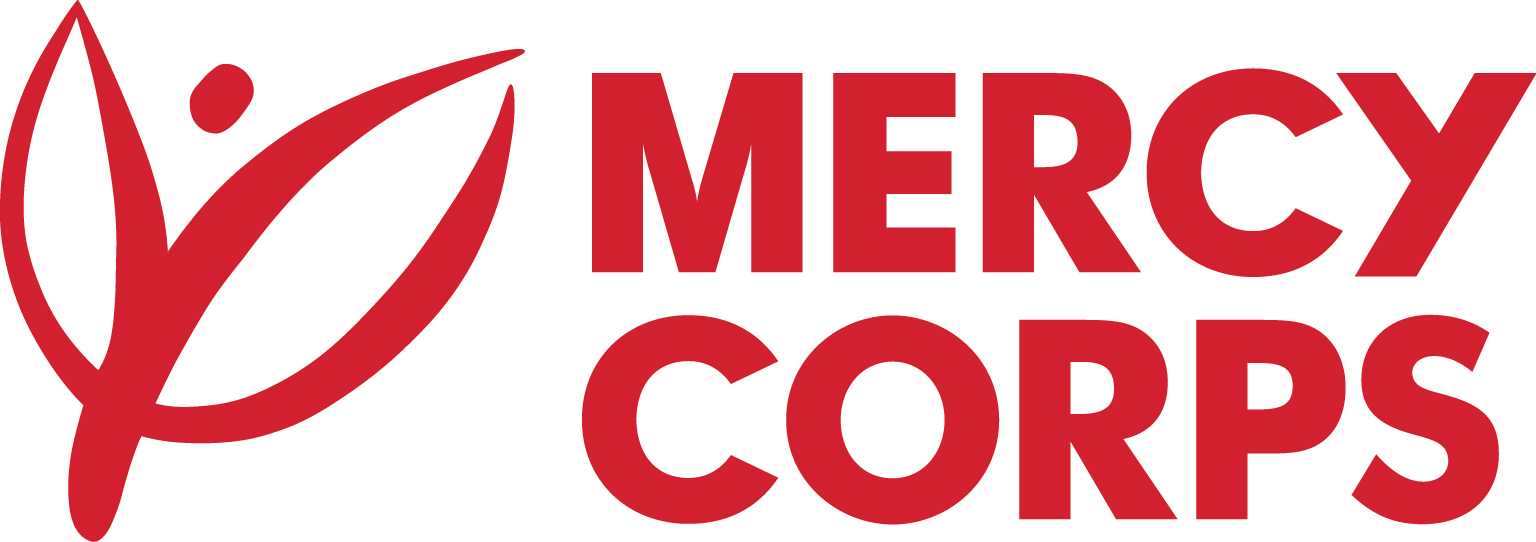
Mercy Corps is another member that takes a multi-tiered approach to addressing agricultural development against climate change. With a focus on promoting community-based management of land and water resources, increasing accessibility, promoting sustainable practices and actively mitigating conflicts using dialogue platforms and incentives, Mercy Corps aims to develop versatile resilience in the agricultural sector. The deployment of sustainable irrigation technology, financing and renewable energy sources also forms the backbone of their approach. Beyond the realm of how farmers conduct themselves and their businesses, Mercy Corps also aims to evaluate market needs and promote the diversification of products accordingly, so that farmers may maximize profits. Post-harvest value is also a priority, seeking to mitigate food waste and reuse products wherever possible. Across the supply chain, the enforcement of uniform quality and safety standards are prioritized to raise the credibility and efficacy of product distribution.
A Climate Pledge
The importance of addressing climate change is solidified in no small part by the declarations of influential actors. The Climate Pledge by Amazon and Global Optimism is one such ambitious framework for building global sustainability, with the target of achieving net-zero carbon emissions by 2040 – a decade ahead of the milestone set by the Paris Agreement.
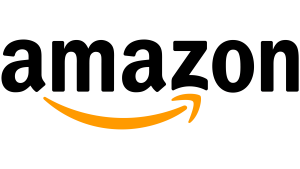
The initiative demands strict self-regulatory principles for signatories in order to meet this goal, including regular measurements and reports of their greenhouse gas emissions, build decarbonizing business models in accordance with guidelines set in place by the Paris Agreement (such as streamlining processes, investing in renewable energy and reducing the organization’s carbon footprint), and combating existing emissions with credible offsets – tangible and long-lasting contributions to the environment that can withstand and undo the damage wrought by human-made climate change. Amazon’s $2 billion contribution to helping signatories implement sustainability measures has secured the participation of industry giants like Verizon, Infosys, and Reckitt Benckiser.
With 414 high-impact signatories across 39 countries, the Climate Pledge is an exemplar framework for restructuring the global industrial ecosystem to work toward environmental resilience and healing.
Institutions are developing and deploying solutions from every sector in their mission to build resilience against climate change. The global food production industry requires consistent innovation and reinforcement at every tier of production, from the individual farmer to the grander systems, supply chains and economies that connect them. The benefits of specialization are evident, as members deploy unique solutions through exhaustive collaboration.
In addition to the above organizations, the following GlobalWA members are working on Climate Action (SDG 13) and Zero Hunger (SDG2) through their programs in communities where they work.
Agros International
Founded in 1984, and inspired by the teachings of Jesus, Agros International’s mission is to break the cycle of poverty and create paths to prosperity for farming families in rural Latin America.
Climate change, agriculture, food security and poverty are deeply intertwined. Current farming methods do not meet the world’s growing demand for food, do not generate enough income for those growing the food, and contribute a third of all greenhouse emissions worldwide. Our work to bring climate-smart agricultural systems to small-scale farmers in rural Nicaragua significantly increases the number of harvests and increases the yield of each harvest—meaning more income and more food is generated on less land with fewer emissions. Using hydroponics and protected structures, our farmers have already contributed to savings in water, use of chemical fertilizers and pesticides, and are mitigating soil erosion with crop rotation and reforestation efforts. Food security and poverty are issues we care deeply about, and we strive to bring solutions that are mutually beneficial to both the farmer and mitigate the effects agriculture has on the environment.
ChildFund
As climate change intensifies, families living in poverty in low-income countries bear the brunt of its impacts, from increases in temperature and changes in precipitation patterns to extreme weather events and reductions in water availability. ChildFund does everything we can to help families navigate the changing environment, including:
- Introducing famers to resilient crops such as moringa, which is fast-growing, nutritious and drought-resistant, and teaching them how to tend to these crops.
- Promoting crop diversification and intercropping — or growing multiple types of crops on a single plot of land, which decreases susceptibility to pests and diseases and minimizes the need for harmful pesticides while promoting biodiversity and increasing yields.
- Teaching farmers improved methods of land management and crop protection, which helps them grow high-yielding crops while preserving farmland through erosion prevention, soil fertilization and organic farming such as using natural pesticides and manure.
- Establishing rainwater harvesting systems, which help to conserve water by redirecting water runoff to storage tanks for later use.
Through these strategies and more, ChildFund is working to improve food security and quality, and helping agricultural households secure a more sustainable income.
To learn more, please visit www.childfund.org or email jlundgren@childfund.org.
Heifer International
Heifer International supports smallholder farmers with the training and tools they need to strengthen local food systems and reduce hunger through sustainable and climate-resilient agriculture.
In partnership with a local farmers’ association in Senegal, ARLS, Heifer International’s Climate Services for Resilience and Productivity project is supporting smallholder farmers adapt to the effects of climate change by providing training, short-cycle seeds and — crucially — climate information through a service that sends agriculture and weather alerts to rural farmers via text and voice messages, as well as information on crop market trends. The project also supports a women-run community radio, which aggregates reports from the field to disseminate climate-relevant information.
In Central and South America, Heifer works to integrate women and Indigenous populations into agricultural value chains including meat, dairy, spices and shellfish. The Green Business Belt program in Guatemala, for example, is supporting 6,250 farmers to close the living income gap in the northern rainforest through sustainable spice production. Farmers are trained in agroforestry practices and linked with technology like more efficient spice dryers to bolster livelihoods while preserving their fragile ecosystem.
The Heifer Ranch Center for Regenerative Agriculture in Arkansas is one of 33 accredited Savory Hubs across the world — a best-in-class agriculture institution training smallholder farmers on holistic land management and regenerative practices. This effort will be instrumental in scaling up regenerative agriculture to meet U.S. climate commitments, training farmers across the country in methods that will generate healthy farmland, while creating more economically viable farm businesses.
Landesa
Landesa champions and works to strengthen land rights for millions of those living in poverty worldwide, primarily rural women and men, to promote social justice and provide opportunity.
Climate change is threatening the land 2.5 billion people depend on to feed their families and grow livelihoods. Land rights are a powerful tool to flip the script from degradation and hunger toward resilient environments and thriving communities. With the knowledge one’s land is secure, rural land users have the incentive and opportunity to make long-term climate-smart investments such as tree planting, soil conservation, and irrigation infrastructure. Ultimately, these investments offer a path to a restored planet and a resilient, food-secure future.
Women are powerful agents in building climate resilience due to their unique roles and possession of knowledge on natural resources within rural and Indigenous communities. In Maldives, Bangladesh, and Nepal, Landesa is building coalitions of women-led organizations to spur climate action and advance women’s land rights. These national coalitions, comprised of civil society organizations, develop and implement strategies to strengthen climate resilience and disaster risk reduction through capacity-building efforts and advocacy at local, national, and regional levels of governance.
Learn more about Landesa’s work on climate change at http://landesa.org/land-rights-for-climate-justice.
Oxfam
Climate change is deepening hunger in 10 of the world’s worst climate hotspots: Afghanistan, Burkina Faso, Djibouti, Guatemala, Haiti, Kenya, Madagascar, Niger, Somalia and Zimbabwe. These countries – which had the highest number of UN appeals driven by extreme weather events – have repeatedly been battered by extreme weather over the last two decades. Today, 48 million people across those countries suffer acute hunger (up from 21 million in 2016), and 18 million people of them are on the brink of starvation.
For millions of people already pummeled down by ongoing conflict, widening inequalities, and economic crises, repeated climate shocks are becoming a backbreaker. The onslaught of climate disasters is now outpacing poor people’s ability to cope, pushing them deeper into severe hunger.
Meanwhile, as humanity faces this existential crisis, the biggest polluting countries continue to make extraordinary wealth: the oil and gas industry has amassed $2.8 billion per day in profits for each of the last 50 years. Less than 18 days of those profits would cover the entire $48.82 billion UN humanitarian appeal for 2022.
Oxfam is calling for rich polluting nations to immediately inject lifesaving funds to meet the UN appeal. To stop the next climate crisis, they must also drastically cut their emissions, guarantee adequate climate financing to help poor people adapt, and above all compensate low-income countries impacted by the climate crisis.
Spoon Foundation
SPOON is a global nonprofit with a mission to empower caregivers around the globe to nourish children who are highly vulnerable to malnutrition. We focus on children with disabilities and children without family care, including children at risk of family separation and children leaving institutional care. These groups of children face particularly high rates of malnutrition, and are often excluded from health and nutrition programs.
We work towards No Hunger through training, tools, and advocacy. Together with local partners, we train professionals and caregivers on nutrition, feeding, and disability. We provide customized support for trainees to assess and respond to issues in nutrition, feeding, and anemia through our app, Count Me In. SPOON and our partners advocate for changes in policy and practice so that all children with disabilities and children without family care have a chance to grow and thrive. Learn more in our annual report.
Our work and the communities we serve are increasingly affected by rising food insecurity, heightened global conflict, and the effects of climate change and the global pandemic. SPOON works in coalition with other organizations to promote a strong, inclusive response to those challenges. This includes pushing for disability inclusion in the Sustainable Development Goals and increased support for early child development globally.
The Hunger Project
The Hunger Project is committed to the sustainable end of world hunger. The impact of climate change on local food systems is already being felt by many around the world. To combat this, THP is working with communities to build resilience and implement practices that will support the regeneration of nature. The solutions vary based on the context and local challenges. For example, in Ethiopia, THP is working with communities to plant millions of trees, restore landscapes and return vital nutrients to the soil to support better food production. In Bangladesh, youth leaders are developing floating gardens that can support the nutrition of families living near floodplains. Finally, in Mexico, we are working with indigenous communities to create nutrition guidelines focused on locally-available crops that respect their food traditions and sovereignty. Through a diverse set of individual and collective actions, like these and others, THP is supporting the food security of communities most impacted by climate change.
Back to Top
Organization Profile
DE Design + Environment Brings Intersectionality to Climate Change
By Tyler LePard
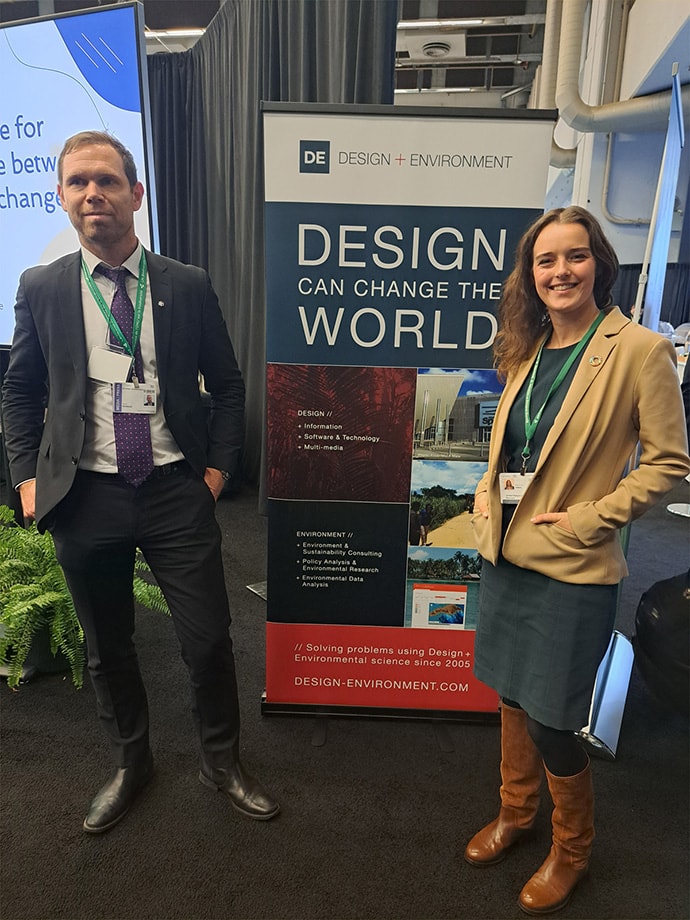
DE at UNCBD COP15 Meetings in Montreal. Photo Credit: DE
DE Design + Environment is an environmental consultancy, design atelier, and a technology company that works around the world. The company was incorporated in Vancouver and launched in Montreal, Quebec, in 2005 by David Oswald.
Origin Story
David was interested in the environment from an early age, which set the stage for the development of this company. When he was young, David spent time in nature and was interested in solar power, making generators, and experimenting with technology. His formal education at the University of Waterloo, Royal Roads University, and McGill laid the foundation for the basis of DE. Before launching the company, David worked in systems engineering, various types of software and tech roles, and in media (film, multimedia, graphics, etc.). David describes himself as a Designer and Environmental Scientist with classical training in Environmental Science and Physical Geography. The majority of his professional experience has stemmed from a technical and scientific creative foundation.
David founded DE Design + Environment to blend creative design work (interior, graphic, and advertising) with environmental work (engineering, consulting, and site assessments) and technology. Eighteen years ago, sustainability wasn’t recognized as central to so many issues as it is today. David started local and then jumped to global work. DE has developed from a small consultancy in Montreal to an internationally recognized and respected company at the forefront of innovation in areas such as climate change, impact analysis, and cross media communications design.
When he started DE Design + Environment, David looked at global environmental problems and tried to figure out how to get work on helping to solve those problems. His goal at the time, was that in 10 years, he’d love to work on a project for an international organization dealing with serious environmental problems in developing countries and helping vulnerable communities. At the same time, he wanted to be doing high-level design work.
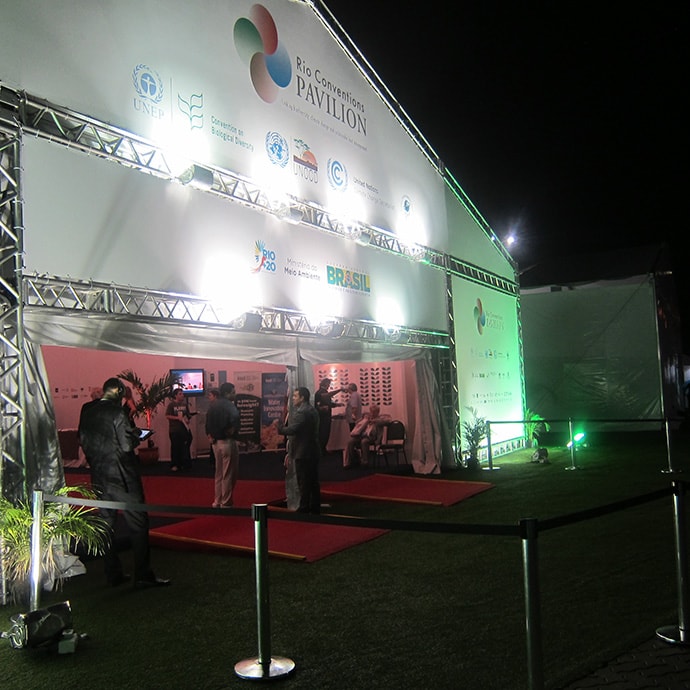
Rio Conventions Pavilion – outside of RCP. Photo credit: DE
DE Design + Environment has been on an interesting journey. In the early days, DE did carbon footprinting for the biggest oil refineries in Canada. Then DE brought David’s unique expertise to the United Nations Convention on Biodiversity and the Rio+20 Summit (United Nations Conference on Environment and Development) in Rio de Janeiro. He also worked on developing software and doing consulting for countries and organizations that are concerned with vulnerable parts of the world, specifically the Caribbean and Latin America. DE’s first international project on site was in the Caribbean to design a regional environmental and atmospheric information system, a database for storing and managing environmental and atmospheric data for the whole Caribbean region to help people make decisions about climate change.
Now DE has become an environmental information systems company – a lot of the work they do now is related to data acquisition and analysis, software development, communications design and systems development for environmental decision-making in various capacities. One of those capacities is to help countries report to the United Nations for the climate convention (UNFCCC). They’re currently working with the government of Jamaica, a few think tanks, the International Institute for Sustainable Development, UN Development Programme, and the UN Environment Programme. DE is also looking to expand into the corporate sector again.
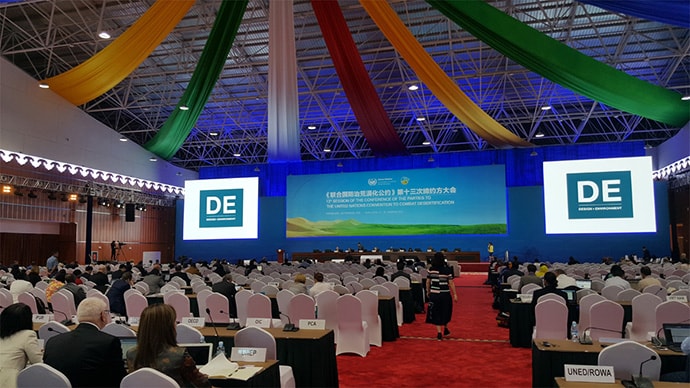
DE presenting on environmental information to support sustainable land management at the UNFCCC COP Conference in Ordos, Mongolia. Photo Credit: DE
Addressing Climate Change and No Hunger
“Food security is a huge issue, as most of us are aware. With the SDGs and climate action, we can’t separate social issues from environmental issues. We have to look at them together. A lot of the projects we work on, they’ll be mandated to address data acquisition and decision-making for food security in addition to climate change,” said David. “A community that is vulnerable to hunger is also vulnerable to climate change, and vice versa.”
For example, DE worked with Guyana and the United Nations (UN) on their green state development strategy to analyze it and come up with indicators to benchmark its progress. Guyana had created that strategy to plan up to 2040 and become food resilient (among other things). DE looked at the levels of poverty, levels of education, agricultural productivity, etc. in addition to greenhouse gas emissions, climate adaptations, and other environmental factors.
On the data side of the business, DE works on the intersection between hunger and climate adaptation for vulnerable communities. On the mitigation side, they address issues like how to make agriculture more climate benign. For instance, they look at different modalities of agroforestry for sequestering carbon and consider how best to monitor that and look at data that supports those decisions. In the middle of all that, DE also works on risk management, specifically related to disasters. They’ve done work on agricultural disaster risk management in Trinidad and Tobago. When there’s a flood, it wipes out food production. Plus, the transportation infrastructure goes, roads get washed out, and it becomes a huge economic and social problem in addition to the physical impacts.

Impact of Floods in Trinidad & Tobago with IICA (Interamerican Institute for Cooperation on Agriculture). Photo Credit: IICA
Intersectionality Between Issues
DE has done a variety of intersectional work between climate adaptation and other issues like gender. “We have to look at all the related impacts–health, security, etc. Some of the conflict issues that arise from climate change, like droughts and water shortages causing social distress can eventually lead to small- or large-scale conflicts. We really need to think about those things in an integrated way,” said David.
Gender is becoming a more prevalent part of the work DE is doing. In the Guyana project, DE was developing a Measurement & Evaluation (M&E) program for their policy framework. DE took a deep look at the framework and how it was structured, then came up with credible metrics they could measure over time and set goals for those metrics. They looked at what it would take to be a “gender positive” country and how to tangibly advance that. For instance, education is an important factor for that goal. Guyana wanted to significantly advance matriculation because very few people were graduating from the equivalent of high school. Considering that the workforce of the future is an educated workforce, DE set the indicators and then an economist identified what it would cost to make that happen. DE disaggregated the data to see education by gender and explored what measures they needed to see advancements on certain policy initiatives.
Last year, DE worked with the International Institute for Sustainable Development (IISD) to design and launch a platform showing National Adaptation Plan (NAP) data. IISD’s resilience program has a group focused on adaptation that works with countries ranging from Fiji to Bolivia to help with their NAPs and analyze them. They established core indicators (100+ variables) and gender is one of them. They focus on a number of different aspects of gender, such as the number of NAPs that mention gender, the context for reference for gender (as a guiding principal, is it a priority, is it cross-cutting, equality as an objective, etc.), and the positioning of women (as a vulnerable group, leaders, etc.). DE created a web-based platform to show the NAP data. It’s a live database that shows the trends. For example, currently 95% of the NAPS submitted mention gender. Another example related to gender is that 51% of NAPs mention sexual and reproductive health and rights (SRHR).
What’s Next
DE Design + Environment has been doing a significant amount of work on designing information systems for countries in the developing world. What David is interested in next, is to take the lessons they’ve learned from the impact that DE has on the ground in vulnerable parts of the world and with countries and social groups, and bring that back into the corporate world, particularly the tech world.

David Oswald, DE President and Founder, delivering keynote presentation on Green Economic Transitions – An International Perspective at Mongolia Mining Week in Ulaanbaatar, Mongolia. Photo Credit: DE
“I think we can bring a lot of value in that respect. Many of these banks and big tech companies are trying to do good work, but what’s problematic for them is that they are accused of green washing. We’d like to work with those powerhouse companies and bring our tech and our expertise–what we do in environmental science and design–but also have a bigger impact where we can. Where is climate change coming from? It’s not small island developing states (SIDS) – they’re subjected to it. I want to come back to the northern developed tech and corporate world and figure out how to do things differently. We’ve got the expertise to work with them on this,” said David.
DE Design wants to be more active in the United States and work more in WA and CA. David says he wants to get back to his creative roots and do more design and multimedia work.
“If there’s one thing that we need to do as a global society, it is to pivot and be creative. We’ve got to find different ways of doing what we’re doing. We need to find ways to decouple environmental and social degradation, or negative externalities, from economic activity and economic development. The sweet spot is using creative approaches, technological advances, agile approaches, and an open mind to look at ways to advance social and environmental agendas, while at the same time making sense from an operational standpoint,” said David. “Leading with design means doing something, not just talking. If we focus on bringing integrated solutions together in very concrete ways, we’ll be successful.”
Back to Top
Goalmaker
Kevin Mugenya, Mercy Corps
By Tyler LePard
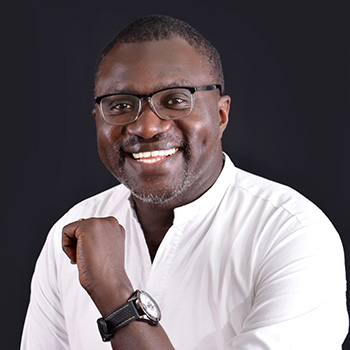
Kevin Mugenya is a Director of Food Systems for Mercy Corps.
“Climate change found me. I wasn’t looking for a career in this area,” said Kevin. “I chose a course that was not popular–dryland resource management. I didn’t go for engineering, medicine, or law because of the context where I’ve lived. Kenya is approximately 80% arid and semi-arid land. That set me up to be where I am now.”
Kevin’s work has journeyed through several issues spanning community level, national and global level, all related to climate change. Kevin started working in dryland resource management (which included work on the environment and climate change) covering the Horn of Africa, then shifted a bit to urban livelihood with short terms assignment in Asia and Latin America. Then he went deeper into working with displaced populations and refugees (both for South Sudan and for Somalia) with a focus on food security and social safety net programming. He left programming in East Africa and worked on food security in Southern Africa and Madagascar (which is one of the countries most affected by climate change). Kevin subsequently left Africa altogether and went to the Middle East and Iraq. Then Covid-19 happened, and he was excited by the job with Mercy Corps and to be back home, closer to family.
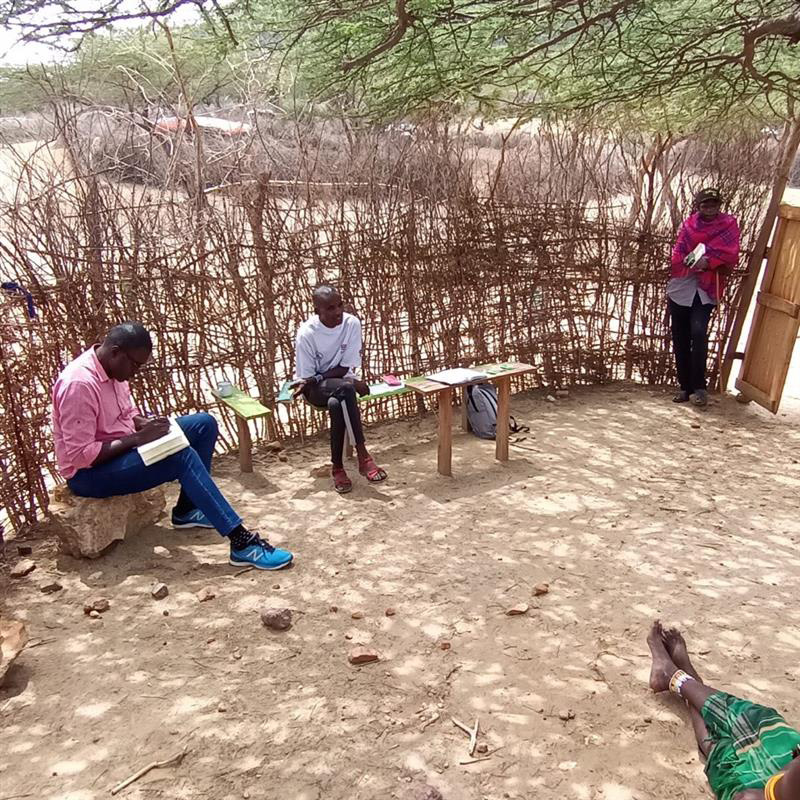
Kevin Mugenya working in the field. Photo: Mercy Corps
“Believe in something and let it drive you toward a certain path.”
Kevin is motivated by his upbringing. He was raised by a single mother. His father passed away when he was six years old. From a very early age, there was a lot of responsibility placed on his shoulders as the first born. In that context, Kevin says, “Life happened – I saw the good, the bad, and the ugly and that propelled me to work hard but still determined to pursue happiness. I buried my head in books.”
Life has thrown many challenges Kevin’s way, but he finds that motivating too, even when things were hard. “When you think you are the best, you interact with someone, and you realize you are not. There’s someone else better than you. When you think you’re down and out, you interact with someone else, and you realize you’re much better off.” He finds inspiration from interacting with other people.
Kevin was inspired by several people early in his career. The first was one of his undergraduate lecturers at The University of Nairobi, Kenya, Dr. Wellington Ekaya. They developed a good rapport and Kevin felt as though Dr. Ekaya had adopted him as one of his sons. The second person was Maurice Makoloo, Kevin’s first supervisor at the Institute for Law and Environmental Governance (ILEG). Mr. Makoloo impressed Kevin with his self-awareness, humility, and ability to interact with people from all walks of life – from a guard to the judges in the supreme court. “One day he would be facilitating a community dialogue, the next day or next week, he’s in a high-level meeting in Mexico representing Kenya,” said Kevin.
Lastly, Kevin was inspired by Dr. Wangari Maathai, who was awarded the Nobel Peace Prize in 2004 (the first Black African woman to win a Nobel Peace Prize). Her story stood out for Kevin because she believed in something and fought the political leadership. “If you visit Nairobi, the Karura Forest and some of the public spaces we enjoy today and hopefully many other generations will is because of what she championed,” said Kevin.
Kevin also gives credit to other people he has worked with, saying they were always two to three steps ahead of what was happening, provided mentorship for him.
“They were all way ahead of their time but stood for a cause. And for me, they taught me to believe in something and let it drive you toward a certain path,” said Kevin.
“In the world we live in, there shouldn’t be anyone dying of hunger.”
Kevin came to work on resilience and food security by working with communities towards sustainable development through natural resource management. Terms change, but Kevin’s early work looking at wetlands, forests, land issues, and how people bounce back from natural disasters was the beginning of his work on resilience. Natural resource management is a bedrock to address and sustain food security. His food security work has focused on different angles, including the emergency perspective of working with refugee camps. In the Middle East, the focus was on early recovery – a bridge between humanitarian and development work, food security, inclusive economic growth through markets, social cohesion and embedding psychosocial support to build the resilience of communities to bounce back and achieve food security. In his current role as Director of Food Systems, Kevin looks at how to build resilient food systems to ensure they deliver food and nutrition security for all and provide equitable livelihoods opportunities in a sustainable way.
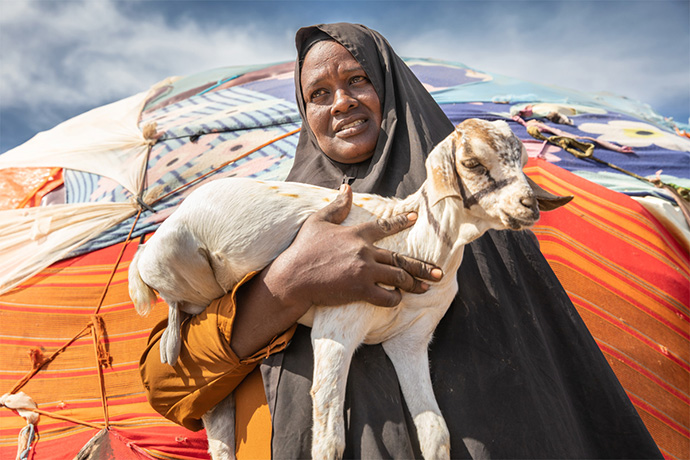
Somalia 2022. Photo: Ezra Millstein/Mercy Corps
“In the world we live in, there shouldn’t be anyone dying of hunger,” said Kevin. However, the world is not equitable and Covid-19 pandemic reversed a lot of gains made towards reducing inequality as it increased a lot of poverty rates and exposed how food systems are vulnerable. If we look at the climatic trends, globally – not just in Africa, but also in the United States (whether it’s forest fires or flooding) and down to Latin America (where there’s displacement of population because of certain weather patterns), you begin to see changing climatic conditions that are expressed as weather conditions, especially depressed rains in most African countries and flooding in most Asian countries. This impacts food production systems and sources of livelihoods for majority especially for rainfed smallholder farmers thus hindering progress towards Zero Hunger.
The increased climate variability is affecting the stability of food production, food supply chains and utilization posing a threat food sovereignty in most countries. Climatic changes pose a challenge to countries striving to be self-sufficient in terms of producing food for their own populations. Every government must pay close attention to the “Zero hunger” Sustainable Development Goal because actions in one country affects another country.
“It’s already happening. Food is the next place where war is happening. For example whoever controls access to inputs such as seeds and fertilizer, agricultural technology, will dominate or control the supply chain of food, control food markets globally, regionally and even nationally thus strongly influencing progress towards Food Sovereignty and most importantly Zero Hunger. The No Hunger SDG is fundamentally important. It’s tied to climate change,” said Kevin. “We all have a common responsibility, but it varies depending on the capacity you have and the resources.”
Kevin says his biggest accomplishment is his ability to reinvent himself again and again throughout his career. He’s thankful for the opportunities he’s received and credits his ability to understand the subject matter, add value, and be curious about what other factors are at play. “Be curious enough to open yourself up to learn. And be humble enough to spend time with people and listen. In any space, I’m able to be relevant,” said Kevin.
Back to Top
May/June Blogs
Heifer International The “Famous” Farmer and Environmental Leader on Senegal’s Community Radio
S M Sehgal Foundation Reviving Millets: A Climate and Nutrition-Smart Cereal
The Hunger Project Planting Seeds of Change
ChildFund The Intersection of Children and the Environment: ChildFund Works with The Coca-Cola Foundation on a Model to Help Kids Secure their Futures
Back to Top
Welcome New Members
Please welcome our newest Global Washington members. Take a moment to familiarize yourself with their work and consider opportunities for support and collaboration!
Committee for Children
For more than 40 years, Committee for Children has been championing the safety and well-being of kids. A leader in the field of social-emotional learning (SEL), we’re dedicated to helping children develop the life skills they need to thrive in the classroom and beyond. Cfchildren.org
Malaria Partners International
Malaria Partners International (MPI) is a group of Rotary members committed to inspiring a broad international Rotarian campaign for global elimination of malaria. MPI believes that malaria can be combated through a comprehensive Rotarian campaign similar to Rotary’s successful Polio Plus campaign. Malariapartnersinternational.org
Back to Top
Member Events
June 8: Construction for Change: Reunite & Rebuild Auction and Gala
June 15: Association for Fundraising Professionals Annual Conference
June 16: Association for Fundraising Professionals Annual Conference
June 21: The State of Humanitarian and Development Cybersecurity
June 24: World Refugee Day – Global Village Festival
Back to Top
Career Center
Senior Consultant, Corporate Communications APCO Worldwide
Program Manager – Partnerships The Max Foundation
Executive Assistant The Max Foundation
Communications & Development Coordinator The Max Foundation
Director, Monitoring, Evaluation, Research and Learning (MERL) HCP Cureblindness
Vice President, Administration & Chief Financial Officer The Max Foundation
Director Global Supply Chain The Max Foundation
Development & Administrative Assistant Amplio
Check out the GlobalWA Job Board for the latest openings.
Back to Top
GlobalWA Events
June 15: Storytelling to Leverage Mainstream Momentum, Yet Stand out From the Crowd (members only)
June 21: Tech Solutions for Climate Action: Harnessing Innovation to Address Climate Change
June 28: Building Bridges to Health: Advancing Global Access to Quality Healthcare
Back to Top
